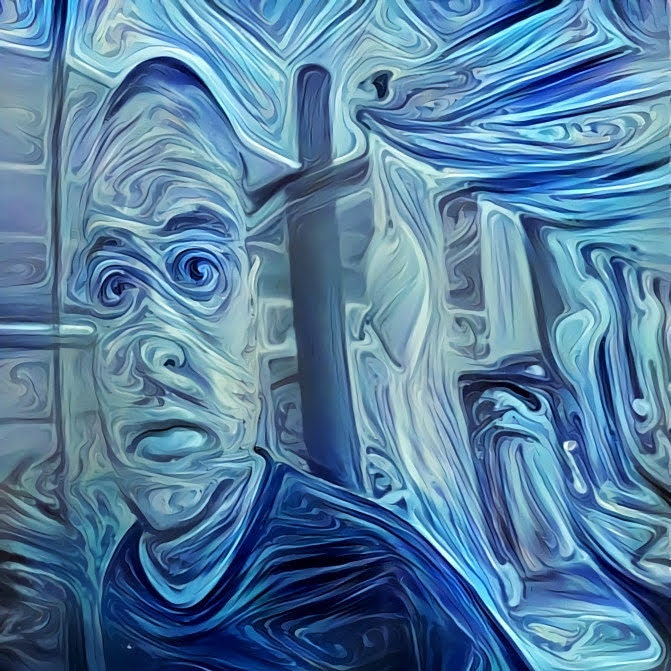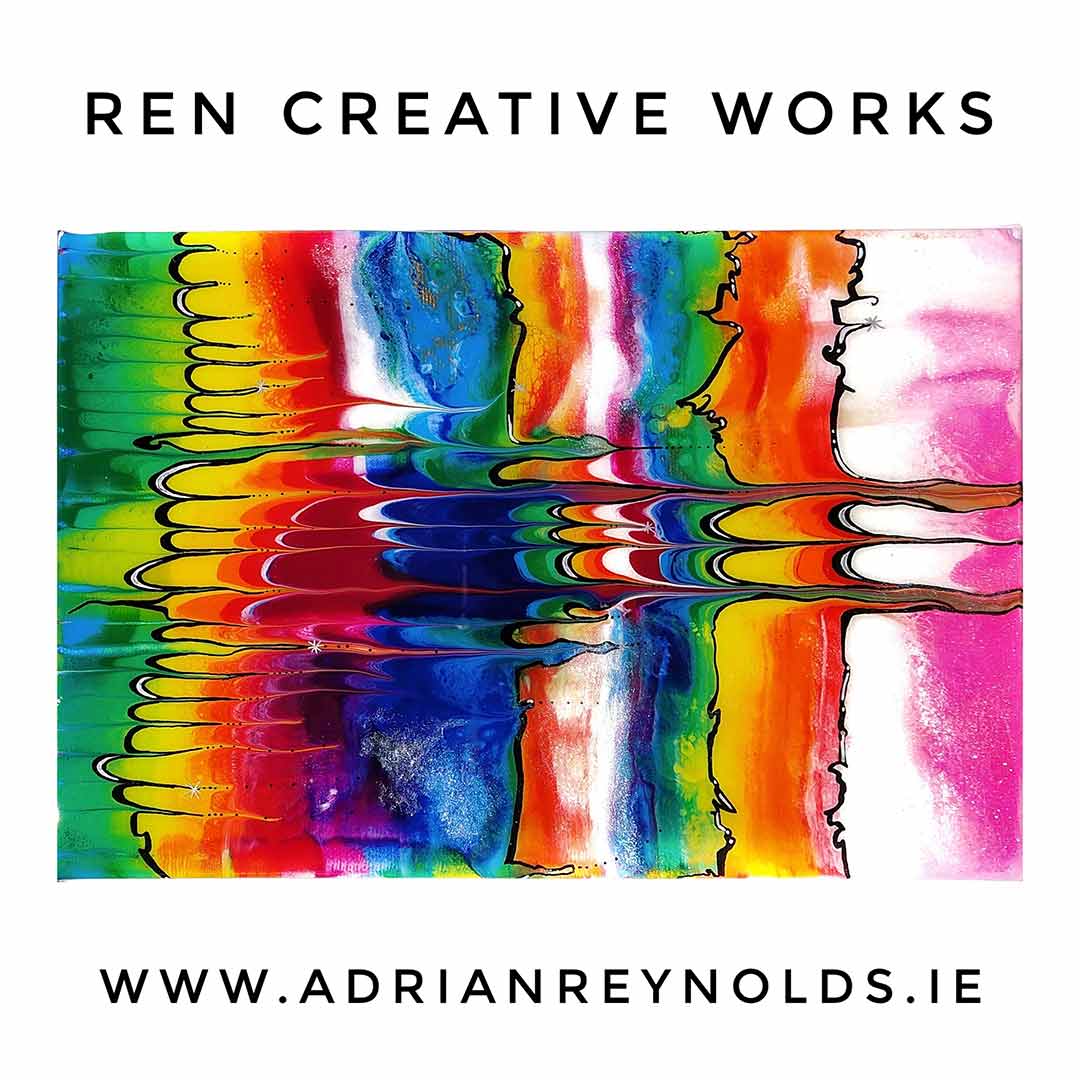10 Questions with Adrian Reynolds "Ren", Irish Artist Extraordinaire.
How Adrian Reynolds (Ren) describes himself on his website, with humility, humour and self-depracating pizzazz really endeared me to him:
"Born in pre-Brexitannia, Luton, England, of both English and Irish heritage, ‘actively over-under achieving in procrastination‘ and fighting off ‘delusions of grandeur’ since 1975, Adrian Reynolds ‘Ren’ is a contemporary Artist/Designer based in Dublin, Ireland."
As a child of the '70's also, and someone who has dabbled in many different creative areas, I felt an instant kinship with Ren, and was very excited to have the opportunity to interview him.
Hope you enjoy this delve into Ren's arts practise!
Q: A lot of your artworks seem to have a deeper message. Do you tend to go into a new artwork with a plan, or is it kind of a “show up on the day” situation??
Sometimes I like to have a rough plan of what I want to achieve and go with it, or sometimes you equally get great results with no plan. One of my early blog posts is about naming art. It does not necessarily have to be cryptic, but I like a title to make you think.
There are so many things that inspire me to paint from photographs, own experience, observation, and imagination. The process of creating artwork, and having total control to make decisions is very liberating. I need a creative outlet, particularly at the moment.
I want to make a positive impact in people's lives, and enhance either their living or work spaces. My real quest is not to create "cookie-cutter" art.
Q: What is your favourite part about working with fluid acrylics and the pouring process?
I really enjoy the techniques of acrylic pouring. The technique is characterised by the lack of control in the process and the challenge this poses.
In the modern world we strive to control everything and always try to maintain a grip on the situation.
Acrylic Fluid Painting allows you to let go of the wheel, and embrace the elements of luck, chance, trial and error, culminating in an output of sheer randomness. Even though this might be difficult and unfamiliar, it can enable you to create something amazing, unexpected and unique.
Although the medium is different, the technique is reminiscence of the ceramic process and beautifully executed Crystalline glazes. Which is a speciality glaze used by ceramists, combining zinc oxide and silica, which creates a visible and distinct crystal growth in the matrix of the fired glaze.
My favourite artwork is the next one I am to do, because for me the process is about continually learning and developing. I think the following quote sums this sentiment:
“Don't think about making art, just get it done. Let everyone else decide if it's good or bad, whether they love it or hate it. While they are deciding, make even more art.”
Andy Warhol
Q: You sometimes include airbrush elements, metallics and even lights into your works, is there a particular material or technique that keeps drawing you in when creating?
I am influenced by so many things around me in this world, and the interconnectivity of the universe. This might be from the movement of a skateboarder or BMX-er flying through the air, to the release of paint through a spray gun.
I have always loved custom automotive paint techniques, to the uncontrollable flow of ceramic glazes. You can learn how to be in control of something, but yet not have total control over it.
Q: Your work “Seafoam” really resonates with me. Typically how long and how many layers would a piece like this take to create?
Actually, you would be surprised that both Sea Foam and Sea Spray were both single pours finished off with an acrylic varnish.
The real time is spent deciding upon the colour palette. I particularly like to consider the way colours can impact human behaviour in either the home or workplace. Obviously, the bigger the canvas will generally require more time.
I would estimate the follow time was required for SeaFoam:
- Prepping paint - 1 hour,
- Pouring - 20 minutes,
- Drying and allowing the acrylic paint to fully cure - 1 week,
- Varnish 2 coats 4 hours between,
- ArtResin 3 days.
Whereas, a piece with multiple layers, or airbrushing, where you might have a lot of masking, can be significantly more time consuming. Obviously, your time is a significant factor when pricing your work.
Another factor to consider is the temperature and humidity of your work environment and the effects this can have on the materials that you use.
Most artists regardless of medium, will usually have a number of artworks on the go at the same time.
Q: If you could go back to 1996, what would you tell your ceramic-studying self?
Looking back 25 years, access and the speed of the internet and technology was nothing compared to what we have today. Maybe some of your readers can remember dial up modems and the limited amounts of computer RAM. In hindsight, I should have taken a more pragmatic look at 3D computer modelling and texture artistry.
Artists don’t realise how much focus is needed on marketing & self promotion, so this is another area I would have looked into more.
However, life is not a dress rehearsal, you have to put yourself out there and be prepared to be disappointed. Keep yourself busy, and if you are in a position to, don’t rule out some voluntary work if you can. It will present yourself in a positive light when you are in between jobs, and you never know what opportunity might present itself.
Most importantly, be true to yourself and think about how much you are being subconsciously influenced by things around you. No one’s life is perfect, there is only one of you and it's ok to not know exactly what you want to do!
"Learning is definitely not mere imitation, nor is it the ability to accumulate and regurgitate fixed knowledge. Learning is a constant process of discovery - a process without end." Bruce Lee
Q: Superstition is such an interesting concept, and your piece “Between 12 and 14” really delves into the topic nicely. Have you ever had anything happen to you, good or bad, that you couldn’t explain through logic?
I suppose we have all experienced things that we can't explain at one time or another, whether good or bad in nature. I'm typically of the view of it being chance and luck, or how one might begin to interpret randomness as a pattern.
We may even fail to notice patterns or perceive ways where there are none, or assign unintended meanings. Linking mathematics through probability, statistics, or even gamblers fallacies would be an interesting concept to explore further in my artwork. (I must remember to write that idea down).
Q: Do you have a goal for the next 5 years? What are you hoping to achieve with your art (and your life) in this time?
My current focus is tapping into and exploring new opportunities and markets. As I mentioned earlier, many artists struggle with the concept that nowadays you really have to spend time marketing yourself. At times, it feels more than the time you spent creating the art.
My art is no better than anyone else’s, after some self-doubt and years of procrastination, my main focus is to continue learning and developing.
I wish to improve my airbrushing skills, through practice, practice, practice! I would love to acquire a laser cutter or engraver at some stage in the future too.
I am interested in how Artificial Intelligence could be applied to fluid pours. Although this has been done already, I would still like to explore it within my work. However, I think I will keep off the Non-Fungible Token (NFT) blockchain bandwagon for the time being!
In addition to my artistic skills, I have been developing my digital marketing and Search Engine Optimization (SEO) knowledge. I encourage anyone interested to explore further, as there are so many fantastic free training resources out there.
Q: Five favourite hobbies apart from creating art?
- Automotive Design;
- Video Games (Concept / Production);
- Films / Music;
- Learning;
- Thinking about what to put down for my fifth favourite hobby...
Q: When did you make the decision to be a full time artist? And how was that transition for you (and your family)?
Although originally from Luton, UK; of both English and Irish heritage, I have been living in Dublin, Ireland for a number of years, and I currently work in the Irish public sector.
To date my career has been quite varied. I have worked in the packaging/print industry, to a Museum in the US. My current career in the public sector allows more time and flexibility to focus on my creativity.
After a long hiatus from creating art, Ren Creative Works was launched at the start of 2020. I look forward to continuing steady progress over the coming years, and exploring new opportunities as they arise.
Q: Tell us something no-one knows about you!
People underestimate my love of a crisp (potato chip) sandwich, along with my other passion of automobile design and history.
Thanks so much Ren for an awesome insight into your life as an artist!
You can follow Ren's blog to read more about his influences and explore advanced art techniques, amazing insider tips, inspirational ideas and expert guidance. Get insights on what he does, what he likes and how he works.
You can find Ren's website here, Facebook here, Instagram here and Twitter here :)
Back to Painting With Acrylics
Back to Explore Acrylic Painting Home























New! Comments
Have your say about what you just read! Leave me a comment in the box below.